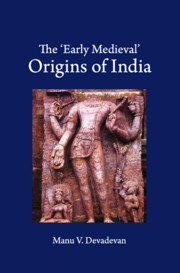Book contents
- Frontmatter
- Dedication
- Contents
- List of Tables
- List of Maps and Figures
- Acknowledgements
- 1 Introduction
- I INSTITUTIONS
- 2 State Formation and Its Structural Foundations
- 3 From the Cult of Chivalry to the Cult of Personality: The Seventh- Century Transformation in Pallava Statecraft
- 4 Changes in Land Relations and the Changing Fortunes of the Cēra State
- 5 Temple and Territory in the Puri Jagannātha Imaginaire
- II IDEAS
- 6 Svayaṃbuddha's Predilections: The Epistemologies of Time and Knowledge
- 7 Bhāravi and the Creation of a Literary Paradigm
- 8 Knowing and Being: The Semantic Universe of the Kūḍiyāṭṭaṃ Theatre
- 9 The Invention of Zero and Its Intellectual Legacy
- III IDENTITIES
- 10 The Evolution of Vernacular Languages: A Case Study of Kannada
- 11 Religious Identities in Times of Indumauḷi's Grief
- 12 Caste, Gender, and the Landed Patriarchy
- 13 The Making of Territorial Self Consciousness (with Particular Reference to Kaliṅga)
- Bibliography
- Index
8 - Knowing and Being: The Semantic Universe of the Kūḍiyāṭṭaṃ Theatre
Published online by Cambridge University Press: 02 May 2020
- Frontmatter
- Dedication
- Contents
- List of Tables
- List of Maps and Figures
- Acknowledgements
- 1 Introduction
- I INSTITUTIONS
- 2 State Formation and Its Structural Foundations
- 3 From the Cult of Chivalry to the Cult of Personality: The Seventh- Century Transformation in Pallava Statecraft
- 4 Changes in Land Relations and the Changing Fortunes of the Cēra State
- 5 Temple and Territory in the Puri Jagannātha Imaginaire
- II IDEAS
- 6 Svayaṃbuddha's Predilections: The Epistemologies of Time and Knowledge
- 7 Bhāravi and the Creation of a Literary Paradigm
- 8 Knowing and Being: The Semantic Universe of the Kūḍiyāṭṭaṃ Theatre
- 9 The Invention of Zero and Its Intellectual Legacy
- III IDENTITIES
- 10 The Evolution of Vernacular Languages: A Case Study of Kannada
- 11 Religious Identities in Times of Indumauḷi's Grief
- 12 Caste, Gender, and the Landed Patriarchy
- 13 The Making of Territorial Self Consciousness (with Particular Reference to Kaliṅga)
- Bibliography
- Index
Summary
The new world, of which Bhartṛhari and Bhāravi appear to us as harbingers, arrived in forms that were by no means fully realized or perfected. Neither did they reach a final stage of evolution or development by the end of the twelfth century. Ideas, identities, and institutions that made their appearance during and after the sixth century were to undergo profound transformations even after the year 1200. There are instances in which the post-twelfth-century transformations brought into being several traditions and practices that shared little with their forerunners. The Kūḍiyāṭṭaṃ theatre of Kerala is one such tradition, and given its current popularity as the oldest surviving tradition of theatre in the world, more than worthy of historical scrutiny.
Kūḍiyāṭṭaṃ is among the few performance forms of the Indian subcontinent that confront us with a strange paradox. It is a genre of dance-drama that is at once nostalgically familiar and frustratingly unintelligible. There is, for instance, an Arjuna on the stage, but it is hard to say what he is up to, for he could throw up surprises for which an audience familiar with the Mahābhārata may not be prepared for. There is a Lakṣmaṇa and a Śūrpaṇaka, a Bhīma, a Jīmūtavāhana, a Yaugandharāyaṇa, a Vasantaka—characters that are known to us as though they have been in conversation with us for long periods of time. They have, nevertheless, metamorphosed into mysterious beings on the stage, doing things that would have perhaps left the playwright ‘spinning in his grave like a dervish’. Vasantaka in the ‘Mantrāṅgaṃ’ of Pratijñāyaugandharāyaṇa has become Kuḻukuṯṯuṇṇi Śarmman, a gluttonous brāhmaṇa jester who is, nonetheless, believed to have attained Śivasārūpyaṃ (likeness with Śiva)! And the Bhīma in the Kalyāṇasaugandhikaṃ has more important offices to minister than bring Draupadi the flower that she longs for. He has to watch a python swallowing an elephant in the forest and witness the appearance of a lion that has reached there to intervene, and he has to do these by playing all characters in the scene on stage—the elephant, the python, the lion, and Bhīma—by transforming from the one to the other through a method of acting called pagaṟnnāṭṭaṃ.
- Type
- Chapter
- Information
- The ‘Early Medieval' Origins of India , pp. 225 - 253Publisher: Cambridge University PressPrint publication year: 2020



